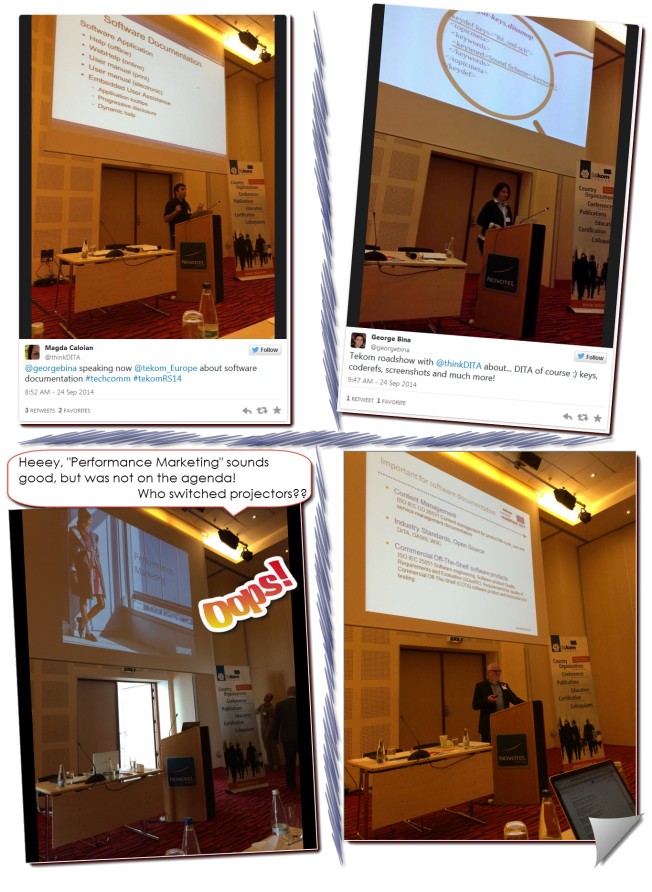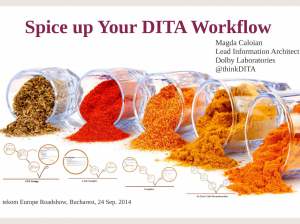English version >> Happy DITA in Germany!
Die letzten Monaten in 2015 waren schon intensiv und ich habe wieder Vieles mitzuteilen, das ich unbedingt in Januar machen werde. Jetzt aber das Wichtigste wäre, mit folgender Aussage ins 2016 zu rutschen: DITA ist und bleibt hier. Das habe ich eine Weile her schon gesagt und sage es erneut, nachdem das steigende Interesse an DITA in Deutschland, unter anderem im November durch Workshops, Vorträge und Podiums im Rahmen der tekom Jahrestagung in Stuttgart und bei DITA Europe in München, noch deutiger wurde. Die DITA Gemeinschaft formt sich langsam, Werkzeuge und Systeme fangen an, DITA zu unterstützen und die Diskussion wird, naja, wenigstens leidenschaftlich.
Letzten September war ich ein bisschen enttäuscht und besorgt… etwa fünf Minuten lang 😉 als eine Gruppe deutschen CMS-Herstellern ein “Whitepaper” gegen DITA herausgegeben hatte. Sie hatten auch ein paar schlecht begründeten Folien, die ihren Kunden von DITA Implementierungen abraten sollten, mit auf einer Rundreise durch Europa genommen hatten. Die Amerikaner nennen solche Stellungnahmen FUD – Furcht, Unsicherheit, Zweifel (fear, uncertainty, doubt). Ich habe mich trotzdem überwunden, über das tragikomische Erwachen der dunklen Seite hinaus zu sehen und das Material durchzulesen. Meine Entscheidung war aber, an solchen nicht produktiven Versuchen nur wenig Aufmerksamkeit zu schenken. Ich werde mich weiter darauf konzentrieren, den DITA Einsatz in Europa und besonders in der deutschsprachigen Gemeinschaft zu unterstützen und Jeder ist willkommen, aktiv mitzumachen.
Auf Wiederstand zu stoßen ist vollkommen normal, wenn es um Änderung geht und kein Experte würde jemals sagen, DITA sei die beste Antwort auf allen Doku-Projekttypen. Doch wenn DITA den Anforderungen und den Audit-Ergebnissen entspricht, müssen professionelle Berater und System-Hersteller die Entscheidungen ihrer Kunden respektieren und ihre Flexibilität zeigen, anstatt eine hochmütige, selbstzerstörerische Antwort zu geben, wie – “Wir machen das seit zwanzig Jahren so und wir sehen keine Notwendigkeit unsere Architektur umzustellen.”
Während der tekom Jahrestagung in Stuttgart und kurz danach haben DITA Experten und Fans, mich eingeschlossen, über vielen interessanten, sowie über ein paar irreführenden Vorträge auf Twitter und Blogs berichtet. Mit viel Geduld und, anders als manche “anti-DITA Gastgeber”, ganz höflich haben Sie die Unklarheiten kommentiert.
Ebenso könnte ich hier noch einen Bericht mitteilen und Verlinkungen zu den Diskussionen auflisten, mein Gefühl über diese Sache sagt mir aber: ist schon genug! Wir sollten diese Debatten beiseitelegen, da der Wettbewerb zwischen Standards oder CMSes soll gesund und ausgeglichen laufen. Wir sollten uns auf die Vorteile für die Kunden und Redakteuren konzentrieren, anstatt uns an negative Aufmerksamkeitstricks zu versuchen. Als Berater und System-Hersteller sollten wir proaktiv zeigen, was wir für unseren Kunden und Partner besonders gut leisten können, egal ob mit DITA, PI-Mod, oder mit weiteren Strukturen (ich, zum Beispiel, habe mehrere davon studiert und implementiert).
Meine Botschaft an die technischen Autoren und Dokumentationsmanager lautet: Ihr Team muss entscheiden, niemals ein System-Hersteller, in Deutschland, wie anderswo auf der Welt, welche Standarde eingesetzt werden. Verfolgen Sie die Neuigkeiten und Anforderungen im Bereich technische Dokumentation und treffen Sie fundierte Entscheidungen. Involvieren Sie Ihre Teams, lassen Sie sie ihre Werkzeuge testen und genau die auswählen, mit denen das Team ihre geschäftliche Ziele erreichen wird.
Vielen Dank für ein wundervolles 2015 und wünsche Allen ein sehr Erfolgreiches 2016. Machen Sie Ihre Teams, Kunden und Anwender wunschlos glücklich!



